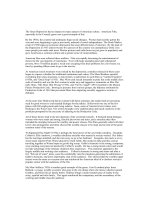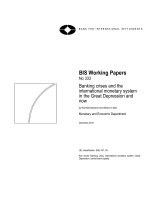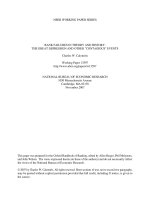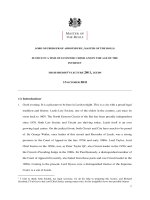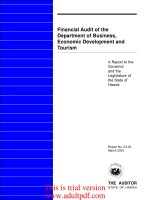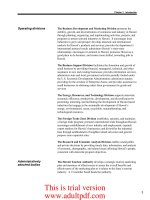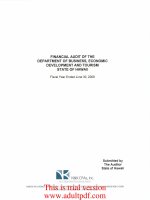The causes of the economic crisis and other essays before and after the great depression
Bạn đang xem bản rút gọn của tài liệu. Xem và tải ngay bản đầy đủ của tài liệu tại đây (1 MB, 230 trang )
THE CAUSES OF THE
ECONOMIC CRISIS
AND OTHER ESSAYS BEFORE
AND AFTER THE GREAT DEPRESSION
LUDWIG VON MISES
The Ludwig von Mises Institute
dedicates this volume to all of its generous donors
and wishes to thank these Patrons, in particular:
Reed W. Mower
~
Hugh E. Ledbetter; MAN Financial Australia;
Roger Milliken; E.H. Morse
~
Andreas Acavalos; Toby O. Baxendale; Michael Belkin;
Richard B. Bleiberg; John Hamilton Bolstad;
Mr. and Mrs. J.R. Bost; Mary E. Braum; Kerry E. Cutter;
Serge Danilov; Mr. and Mrs. Jeremy S. Davis;
Capt. and Mrs. Maino des Granges; Dr. and Mrs. George G. Eddy;
Reza Ektefaie; Douglas E. French and Deanna Forbush;
James W. Frevert; Brian J. Gladish; Charles Groff;
Gulcin Imre; Richard J. Kossmann, M.D.; Hunter Lewis;
Arthur L. Loeb; Mr. and Mrs. William W. Massey, Jr.;
John Scott McGregor; Joseph Edward Paul Melville;
Roy G. Michell; Mr. and Mrs. Robert E. Miller;
Mr. and Mrs. R. Nelson Nash; Thorsten Polleit;
Mr. and Mrs. Donald Mosby Rembert, Sr.; top dog™;
James M. Rodney; Sheldon Rose; Mr. and Mrs. Joseph P. Schirrick;
Mr. and Mrs. Charles R. Sebrell; Raleigh L. Shaklee; Tibor Silber;
Andrew Slain; Geoffry Smith; Dr. Tito Tettamanti;
Mr. and Mrs. Reginald Thatcher; Mr. and Mrs. Loronzo H. Thomson;
Jim W. Welch; Dr. Thomas L. Wenck;
Mr. and Mrs. Walter Woodul, III; Arthur Yakubovsky
~
Mr. and Mrs. James W. Dodds; Francis M. Powers Jr., M.D.;
James E. Tempesta, M.D.; Lawrence Van Someren, Sr.;
Hugo C.A. Weber, Jr.; Edgar H. Williams; Brian Wilton
THE CAUSES OF THE
ECONOMIC CRISIS
AND OTHER ESSAYS BEFORE
AND AFTER THE GREAT DEPRESSION
LUDWIG VON MISES
Edited by Percy L. Greaves, Jr.
Ludwig
von Mises
Institute
AUBURN, ALABAMA
On the Manipulation of Money and Credit © 1978 by Liberty Fund, Inc.
Reprinted by permission.
Originally published as On the Manipulation of Money and Credit in 1978
by Free Market Books.
Translated from the original German by Bettina Bien Greaves and Percy L.
Greaves, Jr.
The Mises Institute would like to thank Bettina Bien Greaves for her support and interest in this new edition.
Foreword and new material copyright © 2006 by the Ludwig von Mises
Institute.
All rights reserved. No part of this book may be reproduced in any manner
whatsoever without written permission except in the case of quotes in the
context of reviews. For information write the Ludwig von Mises Institute,
518 West Magnolia Avenue, Auburn, Alabama 36832; www.mises.org.
ISBN: 1-933550-03-1
ISBN: 978-1-933550-03-9
CONTENTS
FOREWORD by Frank Shostak....................................................................xi
INTRODUCTION by Percy L. Greaves, Jr. ............................................ xiii
CHAPTER 1—STABILIZATION OF THE MONETARY UNIT
—FROM THE VIEWPOINT OF THEORY (1923) ....................................1
I. The Outcome of Inflation ............................................................2
1. Monetary Depreciation ............................................................2
2. Undesired Consequences ........................................................6
3. Effect on Interest Rates ............................................................7
4. The Run from Money ..............................................................8
5. Effect of Speculation ................................................................9
6. Final Phases ..............................................................................10
7. Greater Importance of Money to a Modern Economy ..12
II. The Emancipation of Monetary Value
From the Influence of Government ........................................14
1. Stop Presses and Credit Expansion ....................................14
2. Relationship of Monetary Unit to World Money
—Gold........................................................................................15
3. Trend of Depreciation ............................................................16
III. The Return to Gold ....................................................................18
1. Eminence of Gold ....................................................................18
2. Sufficiency of Available Gold ................................................19
IV. The Money Relation ....................................................................21
1. Victory and Inflation ..............................................................21
2. Establishing Gold “Ratio” ......................................................22
V. Comments on the “Balance of Payments” Doctrine ..........25
1. Refined Quantity Theory of Money ....................................25
v
vi — The Causes of the Economic Crisis
2. Purchasing Power Parity ..................................................26
3. Foreign Exchange Rates ..................................................27
4. Foreign Exchange Regulations ......................................29
VI. The Inflationist Argument ..................................................31
1. Substitute for Taxes ..........................................................31
2. Financing Unpopular Expenditures ..............................32
3. War Reparations................................................................34
4. The Alternatives................................................................35
5. The Government’s Dilemma ..........................................37
VII. The New Monetary System ................................................39
1. First Steps ..........................................................................39
2. Market Interest Rates ......................................................41
VIII. The Ideological Meaning of Reform ..................................43
1. The Ideological Conflict..................................................43
Appendix: Balance of Payments and Foreign
Exchange Rates ..................................................................44
CHAPTER 2—MONETARY STABILIZATION AND CYCLICAL
POLICY (1928) ............................................................................53
A. Stabilization of the Purchasing Power of
the Monetary Unit ........................................................................57
I. The Problem ............................................................................57
1. “Stable Value” Money ......................................................57
2. Recent Proposals ..............................................................58
II. The Gold Standard..................................................................60
1. The Demand for Money..................................................60
2. Economizing on Money ..................................................62
3. Interest on “Idle” Reserves ..............................................65
4. Gold Still Money ..............................................................67
III. The “Manipulation of the Gold Standard” ......................68
1. Monetary Policy and Purchasing Power of Gold ......68
2. Changes in Purchasing Power of Gold ........................71
Contents — vii
IV. “Measuring” Changes in the Purchasing
Power of the Monetary Unit ................................................73
1. Imaginary Constructions ................................................73
2. Index Numbers..................................................................77
V. Fisher’s Stabilization Plan ......................................................80
1. Political Problem ..............................................................80
2. Multiple Commodity Standard ......................................81
3. Price Premium ..................................................................82
4. Changes in Wealth and Income ....................................85
5. Uncompensatable Changes ............................................86
VI. Goods-Induced and Cash-Induced Changes in the
Purchasing Power of the Monetary Unit ..........................88
1. The Inherent Instability of Market Ratios ..................88
2. The Misplaced Partiality to Debtors ............................91
VII. The Goal of Monetary Policy ..............................................93
1. Liberalism and the Gold Standard ................................93
2. “Pure” Gold Standard Disregarded ..............................94
3. The Index Standard ..........................................................96
B. Cyclical Policy to Eliminate Economic Fluctuations ................97
I. Stabilization of the Purchasing Power
of the Monetary Unit and Elimination
of the Trade Cycle ............................................................97
1. Currency School’s Contribution ....................................97
2. Early Trade Cycle Theories ............................................99
3. The Circulation Credit Theory....................................101
II. Circulation Credit Theory ..................................................103
1. The Banking School Fallacy ........................................103
2. Early Effects of Credit Expansion ......................................
3. Inevitable Effects of Credit Expansion
on Interest Rates ............................................................105
4. The Price Premium ........................................................109
5. Malinvestment of Available Capital
Goods ................................................................................109
viii — The Causes of the Economic Crisis
6. “Forced Savings”..............................................................111
7. A Habit-forming Policy ................................................113
8. The Inevitable Crisis and Cycle ..................................113
III. The Reappearance of Cycles ..............................................116
1. Metallic Standard Fluctuations....................................116
2. Infrequent Recurrences of Paper Money
Inflations ..........................................................................117
3. The Cyclical Process of Credit Expansions ..............119
4. The Mania for Lower Interest Rates ..........................121
5. Free Banking ....................................................................124
6. Government Intervention in Banking........................125
7. Intervention No Remedy ..............................................127
IV. The Crisis Policy of the Currency School ......................128
1. The Inadequacy of the Currency School ..................128
2. “Booms” Favored ............................................................130
V. Modern Cyclical Policy ........................................................132
1. Pre-World War I Policy ................................................132
2. Post-World War I Policies ............................................133
3. Empirical Studies ............................................................135
4. Arbitrary Political Decisions ........................................136
5. Sound Theory Essential ................................................138
VI. Control of the Money Market ............................................140
1. International Competition or Cooperation ..............140
2. “Boom” Promotion Problems ......................................142
3. Drive for Tighter Controls ............................................144
VII. Business Forecasting for Cyclical Policy and the
Businessman ..........................................................................146
1. Contributions of Business Cycle
Research............................................................................146
2. Difficulties of Precise Prediction ................................148
VIII. The Aims and Method Cyclical Policy ............................149
1. Revised Currency School Theory ..............................149
Contents — ix
2. “Price Level” Stabilization ............................................151
3. International Complications ........................................152
4. The Future........................................................................153
3—THE CAUSES OF THE ECONOMIC CRISIS (1931) ............................155
I. The Nature and Role of the Market ....................................155
1. The Marxian “Anarchy of Production” Myth ..........155
2. The Role and Rule of Consumers ..............................156
3. Production for Consumption......................................157
4. The Perniciousness of a “Producers’ Policy” ..........159
II. Cyclical Changes in Business Conditions ..........................160
1. Role of Interest Rates ....................................................160
2. The Sequel of Credit Expansion ................................162
III. The Present Crisis ....................................................................163
A. Unemployment ......................................................................164
1. The Market Wage Rate Process..................................164
2. The Labor Union Wage Rate Concept......................166
3. The Cause of Unemployment ....................................167
4. The Remedy for Mass Unemployment ....................168
5. The Effects of Government Intervention ................169
6. The Process of Progress ..............................................171
B. Price Declines and Price Supports ....................................172
1. The Subsidization of Surpluses ..................................172
2. The Need for Readjustments ......................................173
C. Tax Policy ..............................................................................174
1. The Anti-Capitalistic Mentality ................................174
D. Gold Production ..................................................................176
1. The Decline in Prices....................................................176
2. Inflation as a “Remedy” ................................................178
IV. Is There a Way Out? ................................................................179
1. The Cause of Our Difficulties ....................................179
2. The Unwanted Solution ..............................................180
x — The Causes of the Economic Crisis
4—THE CURRENT STATUS OF BUSINESS CYCLE RESEARCH
AND ITS PROSPECTS FOR THE IMMEDIATE
FUTURE (1933) ................................................................................183
I. The Acceptance of the Circulation Credit Theory
of Business Cycles ......................................................................183
II. The Popularity of Low Interest Rates ....................................185
III. The Popularity of Labor Union Policy ..................................187
IV. The Effect of Lower than Unhampered Market
Interest Rates ..............................................................................188
V. The Questionable Fear of Declining Prices ..........................188
5—THE TRADE CYCLE AND CREDIT EXPANSION: THE ECONOMIC
CONSEQUENCES OF CHEAP MONEY (1946) ....................................191
I. The Unpopularity of Interest ..................................................191
II. The Two Classes of Credit........................................................192
III. The Function of Prices, Wage Rates, and Interest Rates ..195
IV. The Effects of Politically Lowered Interest Rates ................196
V. The Inevitable Ending................................................................201
INDEX ........................................................................................................203
FOREWORD
T
his collection of articles on the business cycle, money,
and exchange rates by Ludwig von Mises appeared
between 1919 and1946. Here we have the evidence that
the master economist foresaw and warned against the breakdown of the German mark, as well as the market crash of 1929
and the depression that followed. He presents his business cycle
theory in its most elaborate form, applies it to the prevailing conditions, and discusses the policies that governments undertake
that make recessions worse. He recommends a path for monetary
reform that would eliminate business cycles as we have known
them, and provide the basis for a sustainable prosperity.
In foreseeing the interwar economic breakdown, Mises was
nearly alone among his contemporaries—which is particularly
interesting because Mises made no claim to possessing clairvoyant powers. To him, economics is a qualitative discipline. But
among those who say that economics must be quantitative with
the goal of accurate prediction, neither the pre-monetarists of the
Fisher School nor the Keynesians foresaw the economic damage
that would result from central bank policies that manipulate the
supply of money and credit. Why is this? Most economists were
looking at the price level and growth rates as indicators of economic health. Mises’s theoretical insights led him to look more
deeply, and to elucidate the impact of credit expansion on the
entire structure of the capitalistic production process.
The essays were well known to contemporary German-speaking audiences. They had not come to the attention of English
audiences until 1978, four years after F.A. Hayek had been
awarded the Nobel Prize for, in particular, “his theory of business
xi
xii — The Causes of the Economic Crisis
cycles and his conception of the effects of monetary and credit
policies.” In tribute to Hayek’s excellent contributions, the
Austrian theory of the business cycle has long been called a
Hayekian theory. But it might be more justly called the Misesian
theory, for it was Mises who first presented it in his 1912 book
and elaborated it so fully in the essays presented herein.
Although the articles address issues that were debated many
years ago, the analysis presented by Mises are as relevant today as
they were in his time. Mises reached his conclusions regarding
events of the day by means of a coherent theory, as applied to
current events, rather than attempting to derive a theory from
data alone, as many of his contemporaries did. This is what gave
his writings their predictive power then, and it is what makes his
writings fresh and relevant today. A proper economic theory
such as Mises presents here applies in all times and places.
As in the past, most economists today believe that sophisticated mathematical and statistical methods can torture the data
enough to reveal some causal link between events and yield a theory of inflation and the business cycle. But this is a senseless
exercise. It is no more fruitful than a purely descriptive account
and it has no more predictive value than a simple data extrapolation.
These essays have been buried in obscurity for far too long.
Reading the writings of this great master economist might convince some economists and policy makers that there is no
substitute for sound thinking. Economics is far too important a
subject to be left in the hands of trend extrapolators, data torturers, and monetary central planners who rely on them.
FRANK SHOSTAK
Chief Economist
MAN Financial Australia
March 2006
INTRODUCTION
Every boom must one day come to an end.
— Ludwig von Mises (1928)
The crisis from which we are now suffering is also the outcome of a credit expansion.
— Ludwig von Mises (1931)
I
n the 1912 edition The Theory of Money and Credit, Ludwig
von Mises foresaw the revival of inflation at a time when his
contemporaries believed that no great nation would ever
again resort to irredeemable paper money. This book also presented his monetary theory of the trade cycle, a fundamental
explanation of economic crises. Mises devoted a great part of his
life to attempts to improve and elaborate on his presentation of
what has since become known as the Austrian trade cycle theory.
This volume includes several of those attempts which have not
previously been available in English.
The first, Stabilization of the Monetary Unit—From the
Viewpoint of Theory, was sent to the printers in January 1923, more
than eight months before the German mark crashed. In this contribution, Mises punctured the then popular fallacy that there is not
enough gold available to serve as a sound medium of exchange.
Adapted from the introduction to Ludwig von Mises, On the Manipulation
of Money and Credit, edited by Percy L. Greaves, translated by Bettina Bien
Greaves (Dobbs Ferry, N.Y.: Free Market Books, 1978).
xiii
xiv — The Causes of the Economic Crisis
The second contribution, Monetary Stabilization and Cyclical
Policy, is probably Mises’s longest and most explicit piece on misguided attempts to stabilize the purchasing power of money and
eliminate the undesired consequences of the “trade cycle.” He
goes into more detail and explains more of the important points
on which the monetary theory of the trade cycle is based than he
does anywhere else. It appeared in 1928 and must have been
completed early that year. Yet, with his usual exceptional foresight, he foresaw the futile policies that the Federal Reserve
System was to follow from the 1928 fall election in the United
States until the stock market crashed the following fall.
Mises pointed out that if it ever became the task of governments to influence the value of money by manipulating the
quantity of its monetary units, the result would be a continual
struggle of politically powerful groups for favors at the expense of
others. Such struggles can only produce continual disturbances
with results far less “stable” than the rules of the gold standard.
In the first section of this essay, Mises demonstrates the
inevitable failure of all attempts to attain a money with a “stable”
purchasing power by manipulating the quantity. As he expresses
it,
There is no such thing as “stable” purchasing power, and
never can be. The concept of “stable value” is vague and
indistinct. Strictly speaking, only an economy in the
final state of rest—where all prices remain unchanged—
can have a money with fixed purchasing power.
Mises shows conclusively that purchasing power cannot be
measured. Consequently, there is no scientific basis for establishing a starting point for such an unattainable idea. The very
concept of “stable value” denies flexibility to the myriads of market prices which actually reflect the ever-changing subjective
values of all participants.
No one knows the future, but so far as market participants can
foresee the future, the anticipated future purchasing power of
any monetary unit will be reflected in the “price premium” factor
Introduction — xv
in market interest rates. If prices are expected to rise continually,
the longer the period of a loan, the higher the interest rate will be.
Before the German mark crashed in 1923, interest rates of 90
percent or more were considered low.
Mises also points out that those who save and lend their savings to productive efforts play a major role in raising production
and living standards. It would seem that they are entitled to the
free market fruits of their contributions. As just mentioned,
unmanipulated interest rates would reflect market expectations
of changes in the purchasing power of the monetary unit.
However, if the principal of loans could be, and always were,
repaid with sums representing the purchasing power originally
borrowed, the lending savers would be prevented from sharing in
the general progress and resulting lower prices their savings
helped make possible. Then everybody but the lending saver
would benefit from his savings.
This would, of course, reduce the incentive for people to lend
their savings to those who can make a more productive use of
them. With less production, the living standards of all consumers
would fall. So the “stable money” goal, even if it were achievable,
would be a stumbling block to progress. All progress is the result
of free-market incentives which lead enterprisers to attempt to
improve on the “stable” patterns of the past.
Mises also refers to the fact that deflation can never repair the
damage of a priori inflation. In his seminar, he often likened such
a process to an auto driver who had run over a person and then
tried to remedy the situation by backing over the victim in
reverse. Inflation so scrambles the changes in wealth and income
that it becomes impossible to undo the effects. Then too, deflationary manipulations of the quantity of money are just as
destructive of market processes, guided by unhampered market
prices, wage rates and interest rates, as are such inflationary
manipulations of the quantity of money.
The second part of the 1928 piece is a masterpiece in which
Mises shows how the artificial lowering of interest rates intensifies the demand for credit that can only be met by a credit
xvi — The Causes of the Economic Crisis
expansion. This addition to the quantity of money that can be
spent in the market place must lead to a step-by-step redirection
of the economy by raising certain prices and wage rates before
others are affected, as the recipients of this newly created credit
bid for available supplies of what they want but could not buy
without having obtained the newly created credit.
Mises was then writing at a time when such credit expansion
was primarily in the form of discounting short term (not longer
than 90 days) bills of exchange. Consequently, such loans were
always business loans. The first consequence was always a bidding up of the prices of certain raw materials, capital goods, and
wage rates, for which the borrowers spent their newly acquired
credit. This has led some writers on the subject to believe that all
such loans went into the lengthening of the production period.
Some did, of course, but Mises recognized that the lower interest
rates attracted all producers who could use borrowed funds.
Consequently all the resulting malinvestment does not result in
longer processes. The effects depend on just who the borrowers
are and how they spend their new credit in the market.
Since 1928, banks have extended credit expansion not only to
business but also to consumers, and not only for short term loans
but also for long term loans, so that the specific effects of credit
expansion today are somewhat different than they were in the
1920’s. However, the results are still, as Mises pointed out, a stepby-step misdirection in the use and production of available goods
and services. As Mises wrote in 1928, as well as in Human Action,
the result is not overinvestment, as some have thought, but malinvestment. Investment is always limited by what is available.
Although later and better statistics are now available and the
Harvard “barometers” have been superseded by computer models, what Mises said then about the Harvard “barometers” also
applies to the statistics gathered and rearranged by the more
sophisticated computer techniques of today. Such research materials may support Mises’s theory, but they provide little help in
furnishing an answer to the problem of finding the cause of
recessions and depressions so that the cause may be eliminated.
Introduction — xvii
The answer, as Mises attests, is a return to free market interest
rates which restrain loans to available savings, i.e., the elimination
of credit expansion, a system whereby banks lend more funds than
they have available for lending by the artificial creation of monetary units in the form of bank accounts subject to withdrawal by
checks. Mises saw the answer in free banking, with banks subject
only to the commercial and bankruptcy laws that apply to all other
forms of business.
In 1928, Mises also foresaw the attempts now being made to
remove the brakes on credit expansion by international agreements. He recognized that if all major governments could ever be
persuaded to expand credit at the same rate, it might then
become more difficult for the residents of individual countries to
detect the expansion or to check the expansion by sending their
funds to countries where there was less credit expansion.
While Mises refined his presentation, particularly his scientific terminology, by the time he wrote Human Action, this 1928
contribution establishes him as the unquestioned originator of
the monetary “Austrian” theory of the trade cycle. Others have
since written on the subject. None has substantially added to, or
subtracted from, his presentation.
This basic explanation is very late in appearing in English. It is
to be hoped that it will correct some of the misunderstandings
resulting from the writings of others that have preceded its
English appearance. This great contribution to human knowledge should be read by all those interested in saving our
capitalistic civilization and capable of spreading a better understanding of the inherent dangers to our society in the political
manipulation of money and credit.
The third contribution, The Causes of the Economic Crisis, is a
translation of a speech he gave at the depth of the Great
Depression on February 28, 1931, before a group of German industrialists. After a clear but simple presentation of consumer
sovereignty in an unhampered market society, Mises described
how the lowered interest rates produced the then current crisis. He
goes on to explain the duration of the crisis as the result of other
interventionist hamperings of market processes. He shows that
xviii — The Causes of the Economic Crisis
continued mass unemployment is due to interference with free
market wage rates. He also shows how political interventions
affecting prices, as well as heavy taxes on capital and its yield, had
hindered recovery.
In this speech, five years before the appearance in 1936 of
Keynes’s The General Theory of Employment, Interest and Money,
Mises made a devastating criticism of the basic Keynesian tenet
that has since become so popular. It is the idea that inflation can
bring the higher than free market wage rates extorted by labor
unions into a viable relationship with other costs. Accepting the
idea that it was politically impossible to reduce the higher than
free market union wage rates that had produced mass unemployment, Keynes proposed to lower the real wages of all workers by
lowering the value of the monetary unit, i.e., inflation.
Unfortunately, England’s inflation only lowered the real wages of
the privileged union members temporarily, while disorganizing
the nation’s whole market economy. This, in turn, created a
clamor for more political interventions that sponsors hoped
would correct the undesired results of the inflation.
Mises correctly foresaw that the politically feared labor unions
would, sooner or later, insist on higher money wages. The eventual solution, as Mises has maintained, must be a return to free
market wage rates. He was certainly many years a head of his
time. There is still a popular feeling that inflation is a means of
offsetting unemployment, with little recognition that such inflations must inevitably lead to the undesired recessionary
consequences that every responsible person wants to prevent.
The fourth piece is a translation of a 1933 contribution he
made to Arthur Spiethoff ’s Festschrift devoted to the status and
prospects of business cycle research. Mises used to say that all a
good economist needed was some sound ideas, writing materials,
an armchair, and a waste basket. He, of course, recommended
wide reading but he insisted that it was the ideas that were
important and that without ideas all statistics were meaningless.
In this piece Mises comments on the clamor for cheap credit.
Throughout history there have been governments that have
sponsored high prices and governments that have sponsored low
Introduction — xix
prices, but all governments have been advocates of low interest
rates. Politicians never seem to learn that the best way to attain
low interest rates is to stop inflating the quantity of money and
remove all obstacles to the greater accumulation of capital. Mises
also explodes the naïve inflationist theory that prosperity
requires ever-rising prices.
The final piece is not a translation. It was prepared in early
1946 for an American business association for which Mises served
as a consultant. He discusses his cycle theory in the American
milieu and points out that low interest rates actually hurt the
American masses who, as savings bank depositors, life insurance
policy holders and beneficiaries of pension funds, are the creditors of large corporations and governmental bodies which are
today the major borrowers of savings. He also gives a clear explanation of the important difference between “commodity credit”
and “circulation credit.” It is the latter which is so disastrous in disorganizing free market guidelines. Our real problem is not a
shortage of money, but a shortage of the factors of production
needed to produce more of the things that consumers want.
While Mises’s most valuable contributions were not always
easy reading, he did not lapse into abstruse or convoluted esoterics. He wrote what he had to say simply and directly, perhaps on
some occasions too simply and too concisely for many readers to
grasp the full implications which he did not always spell out. He
had a dislike for translations. He maintained that each language
group had some ideas, customs, and traditions which were
impossible to translate accurately into the languages of another
language group with different ideas, customs, and traditions. He
would ask, how could such thoroughly American traditions as
college fraternities and football extravaganzas be translated into
the German language, which had no precise terms for expressing
such alien ideas.
My wife, Bettina Bien Greaves, started these translations a few
years after she became a student of Mises. In the years that have
intervened, she has become one of his most careful students. She
prepared a bibliography of his works, catalogued his library,
attended his seminar for eighteen years, and assisted him in
xx — The Causes of the Economic Crisis
many ways. In 1971, Mises approved the publication of these
translations when he was assured that they would be edited by
the undersigned, also a long-time and serious student of Mises’s
ideas.
The completion of this project has taken longer than expected.
However, no effort has been spared in the attempt to present
Mises’s ideas in a form we hope he would have approved. We trust
this volume will lead to a better understanding of Mises’s contributions to man’s knowledge of money, credit, and the trade cycle.
PERCY L. GREAVES, JR., EDITOR
July 4, 1977
1
STABILIZATION OF THE MONETARY UNIT—
FROM THE VIEWPOINT OF THEORY (1923)
A
ttempts to stabilize the value of the monetary unit
strongly influence the monetary policy of almost every
nation today. They must not be confused with earlier
endeavors to create a monetary unit whose exchange value would
not be affected by changes from the money side.1 In those olden,
and happier times, the concern was with how to bring the quantity of money into balance with the demand, without changing
the purchasing power of the monetary unit. Thus, attempts were
made to develop a monetary system under which no changes
would emerge from the side of money to alter the ratios between
the generally used medium of exchange (money) and other economic goods. The economic consequences of the widely
deplored changes in the value of money were to be completely
avoided.
Die geldtheoretische Seite des Stabilisierungsproblems (Schriften des Vereins
für Sozialpolitik 164, part 2 [Munich and Leipzig: Duncker and Humblot,
1923]). The original manuscript for this essay was completed and submitted by the author to the printer in January 1923, more than eight months
before the final breakdown of the German mark.
1[Following the terminology of Carl Menger, Mises wrote here of changes
in the “internal objective exchange value” of the monetary unit. However,
in this translation, the more familiar English term, later adopted by Mises,
will be used—i.e, changes in the value of the monetary unit arising on the
money side or, simply, “cash-induced changes.” Menger’s term for changes
in the monetary unit’s “external exchange value” will be rendered as
“changes from the goods side” or “goods-induced changes.” See below p. 76,
note 17. Also Mises’s Human Action (1949; 1963 [Chicago: Contemporary
Books, 1966], p. 419; Scholar’s Edition [Auburn, Ala.: Ludwig von Mises
Institute, 1998], p. 416).—Ed.]
1
2 — The Causes of the Economic Crisis
There is no point nowadays in discussing why this goal could
not then, and in fact cannot, be attained. Today we are motivated
by other concerns. We should be happy just to return again to the
monetary situation we once enjoyed. If only we had the gold standard back again, its shortcomings would no longer disturb us; we
would just have to make the best of the fact that even the value of
gold undergoes certain fluctuations.
Today’s monetary problem is a very different one. During and
after the war [World War I, 1914–1918], many countries put into
circulation vast quantities of credit money, which were endowed
with legal tender quality. In the course of events described by
Gresham’s Law, gold disappeared from monetary circulation in
these countries. These countries now have paper money, the purchasing power of which is subject to sudden changes. The
monetary economy is so highly developed today that the disadvantages of such a monetary system, with sudden changes brought
about by the creation of vast quantities of credit money, cannot be
tolerated for long. Thus the clamor to eliminate the deficiencies in
the field of money has become universal. People have become convinced that the restoration of domestic peace within nations and
the revival of international economic relations are impossible without a sound monetary system.
I.
THE OUTCOME OF INFLATION2
1. MONETARY DEPRECIATION
If the practice persists of covering government deficits with
the issue of notes, then the day will come without fail, sooner or
later, when the monetary systems of those nations pursuing this
course will break down completely. The purchasing power of the
2[Mises uses the term “inflation” in its historical and scientific sense as an
increase in the quantity of money.—Ed.]
Stabilization of the Monetary Unit—From the Viewpoint of Theory — 3
monetary unit will decline more and more, until finally it disappears completely. To be sure, one could conceive of the possibility
that the process of monetary depreciation could go on forever.
The purchasing power of the monetary unit could become
increasingly smaller without ever disappearing entirely. Prices
would then rise more and more. It would still continue to be possible to exchange notes for commodities. Finally, the situation
would reach such a state that people would be operating with billions and trillions and then even higher sums for small
transactions. The monetary system would still continue to function. However, this prospect scarcely resembles reality.
In the long run, trade is not helped by a monetary unit which
continually deteriorates in value. Such a monetary unit cannot be
used as a “standard of deferred payments.”3 Another intermediary
must be found for all transactions in which money and goods or
services are not exchanged simultaneously. Nor is a monetary unit
which continually depreciates in value serviceable for cash transactions either. Everyone becomes anxious to keep his cash holding, on
which he continually suffers losses, as low as possible. All incoming
money will be quickly spent. When purchases are made merely to
get rid of money, which is shrinking in value, by exchanging it for
goods of more enduring worth, higher prices will be paid than are
otherwise indicated by other current market relationships.
In recent months, the German Reich has provided a rough
picture of what must happen, once the people come to believe
that the course of monetary depreciation is not going to be
halted. If people are buying unnecessary commodities, or at least
commodities not needed at the moment, because they do not
want to hold on to their paper notes, then the process which
forces the notes out of use as a generally acceptable medium of
exchange has already begun. This is the beginning of the “demonetization” of the notes. The panicky quality inherent in the
operation must speed up the process. It may be possible to calm
3[Here in the German text Mises used, without special comment, the
English term “standard of deferred payments.” For his reasons, see below, p.
58, note 3.—Ed.]
4 — The Causes of the Economic Crisis
the excited masses once, twice, perhaps even three or four times.
However, matters must finally come to an end. Then there is no
going back. Once the depreciation makes such rapid strides that
sellers are fearful of suffering heavy losses, even if they buy again
with the greatest possible speed, there is no longer any chance of
rescuing the currency.
In every country in which inflation has proceeded at a rapid
pace, it has been discovered that the depreciation of the money
has eventually proceeded faster than the increase in its quantity.
If “m” represents the actual number of monetary units on hand
before the inflation began in a country, “P” represents the value
then of the monetary unit in gold, “M” the actual number of
monetary units which existed at a particular point in time during
the inflation, and “p” the gold value of the monetary unit at that
particular moment, then (as has been borne out many times by
simple statistical studies):
mP > Mp.
On the basis of this formula, some have tried to conclude that
the devaluation had proceeded too rapidly and that the actual
rate of exchange was not justified. From this, others have concluded that the monetary depreciation is not caused by the
increase in the quantity of money, and that obviously the
Quantity Theory could not be correct. Still others, accepting the
primitive version of the Quantity Theory, have argued that a further increase in the quantity of money was permissible, even
necessary. The increase in the quantity of money should continue, they maintain, until the total gold value of the quantity of
money in the country was once more raised to the height at
which it was before the inflation began. Thus:
Mp = mP.
The error in all this is not difficult to recognize. For the
moment, let us disregard the fact—which will be analyzed more
fully below—that at the start of the inflation the rate of exchange
on the Bourse,4 as well as the agio [premium] against metals,
4Bourse (French). A continental European stock exchange, on which
trades are also made in commodities and foreign exchange.



